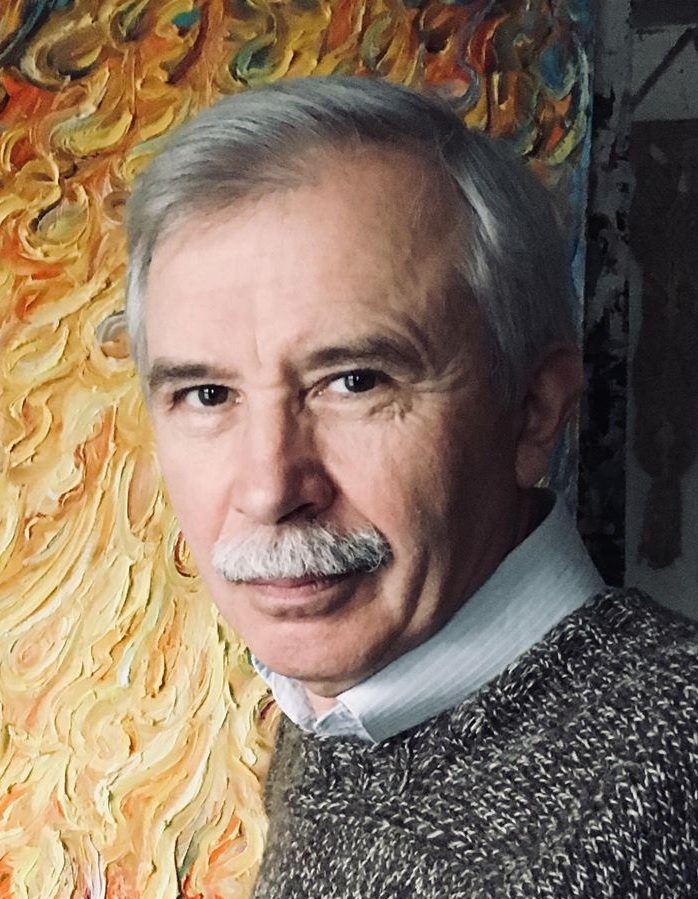
Virginijus Kašinskas is a painter and Lithuanian mythology researcher. His creative work is driven by Lithuanian mythology, rituals, traditions and symbols. Born on 15 May 1955, in Silale District, Samogitia, Lithuania. Painter. Since 1992 is member of Lithuanian Artists Association.
1977 – 1981 studied in Kaunas Art School.
1981 – 1987 studied in Vilnius Art Academy, graduated and acquired the speciality of an artist- painter.
1987 – 1992 in Kaunas J.Naujalis Art School (at present Art Grammar School) taught drawing.
1992 – 1996 creative work. 1996 – 2021 worked as associate professor of drawing and painting in Vilnius Art Academy, Kaunas Faculty of Art. Since 2021 – creative work.
Participated in 106 exhibitions among them organized 98 one-man exhibitions of paintings, drawings and photography in Lithuania and abroad. Participant of republican and international painting exhibitions in Lithuania and abroad. Participant of international and Lithuanian painting plain-airs. Participated in a number of art auctions in which his paintings were purchased. His works have been acquired by art admirers and collectors of Lithuania, Poland, Russia, Germany, USA, Canada, France, Luxemburg, Denmark and Israel.
Is interested in Lithuanian mythology, studies and gathers information on Lithuanian ethnic culture, necrocult traditions, sacral ritual signs and symbols, ornaments and colouristics. He has collected an exhaustive coloured slides, negatives and photography collection about it. On these subjects he lectures, publishes articles in the press, participates in conferences and culturological plain-airs.
Virginijus Kasinskas is definitely a studio hermit and painting fanatic. Individual pieces were featured in various Lithuanian galleries in 1987, but most of his efforts were directed toward personal exhibitions for a small but educated circle of art aficionados.
In his paintings the artist highlights the basic spiritual and physical elements of life and seeks to create the harmonizing structure of both spheres. He avails himself of diverse systems of artistic expression for detailed treatment of objects .
His preferred cyclical form of developing a theme is based on realism, surrealism, expressionism and abstractionism. He also uses his knowledge of anatomy, mathematics and philosophical systems as well as ancient symbolism.
His first independent works were dedicated to his native Zemaitija.
Childhood memories, familiar traditions, the study of local art and ethnographic excursions formed the basis of his research. In his opinion, Zemaitija offers all fundamental structures connecting the various spheres of life.
Central to this area of his work is the series of 40 paintings called “Raudos” (Lamentations). Through historical images, the layering of paints, depicted illusions and background drawings the artist conveys a complex and dramatic scene . The dynamic of the composition is strengthened by the rhythmic, symbolic and contextual placement of forms. A surrealistic vision gradually emerges, overstepping conventional boundaries ( for example, in the 8 canvases and 2 mirrors of the composition “Amzinoji rauda” (Eternal Lamentation) and even infringing upon the viewer space. The structural accent affects the portrayal of persons to a great degree. Figures appear torn by spiritual forces. Often instead of people we see only characteristic structural elements. For this reason in paintings of a universal nature, the artist rejects representational figures. Most paintings in the “Archaines kompozicijos” (Archaic Compositions) cycle tend toward geometric abstractionism. The basic structures found in earlier works are physically connected to ancient Baltic ornamentation depicting the order of the universe. He also uses art forms and colour schemes common to Zemaitija. In his treatment of heavenly bodies (especially solar compositions) Kasinskas employs a complex system of colour and numerical symbolism. The pulsing rhythm is continued into the surrounding space through the use of unusual frames. Such works are closely linked to the spheres of religion and science.
The “Kosmogonines kompozicijos” (Cosmogonic Compositions) cycle is the zenith of his work in this trend. The decorative brightness of his colours reveals the ideal, crystal clear world of the heavens.
Menotyrininkas Saulius Mikėnas
